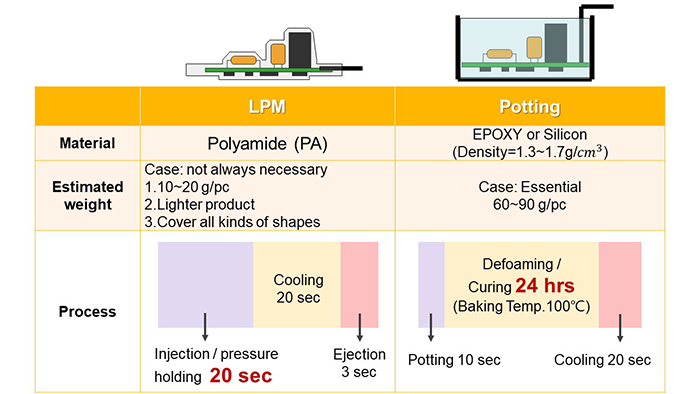) (1)_pic.jpg)
Low Pressure Molding (LPM) is a plastic molding process that injects thermoplastic materials into a mold. Compared to traditional plastic injection techniques, LPM is a novel method characterized by encapsulating electronic components with plastic materials under lower pressures. This securely packages those minute and intricate PCB electronic components.
PCB's New Encapsulation Process
The encapsulation process of low pressure molding starts by placing exposed and unprotected Printed Circuit Boards (PCB) and wire assemblies into a mold. Subsequently, a low-pressure injection machine is used to inject low-pressure material into the mold for filling. This material impeccably encapsulates electronic components in the desired shape, completely sealing and protecting the components. It facilitates swift production of a PCB ready for circuit testing.
Unencapsulated PCB → Mold Preparation → Low-Pressure Injection → Completion of Encapsulation → Immediate Circuit Testing.
Why the Electronics Industry is Adopting Low Pressure Molding?
Traditional plastic manufacturing processes require high temperatures and pressures, conditions that can easily damage PCBs. Meanwhile, the conventional potting process, using epoxy potting materials, has long production cycles, extended waiting periods, large space requirements, and environmental pollution concerns. On the contrary, LPM utilizes very low viscosity thermoplastic materials, allowing the safe encapsulation of the most sensitive PCB electronic components. These encapsulation materials are inherently adhesive, ensuring circuits are perfectly sealed, effectively blocking dust and moisture. In many cases, its water-resistance can reach an IP68 rating. This technology is widely used in electronics, electrical, and medical fields, offering the following benefits:
- Increased Production Efficiency: LPM is faster than potting, resulting in shorter cycles.
- Improved Product Performance: LPM yields higher rates of successful PCB encapsulations, offers diverse shape appearances, and provides longer lifespan and improved resilience against shocks and water for PCB/PCBA components.
- Overall Cost Reduction: Taking into account time, space, yield rate, labor costs, environmental impact, and carbon emissions, LPM is more cost-effective than potting.

Significance of Mold Design
Ensuring complete and correct filling of the low-pressure mold is crucial. Mold flow analysis is pivotal. By simulating various injection points and flow paths through computer modeling, it predicts how the material will flow inside the mold, ensuring optimal quality and appearance of the end product.
Expert Consultation Services from KING's
KING's has amassed over a decade of invaluable experience in the realm of low pressure molding. We've assisted numerous major electronic OEMs from various countries, accumulating vast practical knowledge and experience. While some perceive the LPM process as simple, it encompasses many technical nuances and challenges. With our background in injection molding machine development, we possess an in-depth understanding of hot melt polyamide materials and mold design.
From machine design and mold design to the selection of low pressure molding materials, KING's offers unparalleled and irreplaceable expertise. Leveraging this experience, you'll achieve superior processes and quality products. Let our consultants guide you through this novel process. The expertise and experience of KING's will save you substantial time, ensuring your products reach the market promptly.
